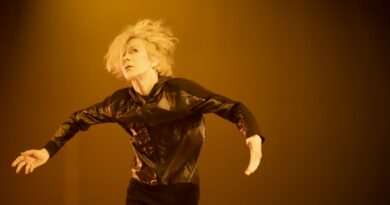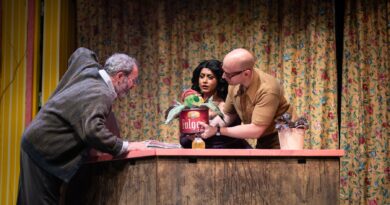Soulpepper’s ROSE asks: “Who am I?” The answer is a delight.

Last week, Soulpepper premiered Rose, the final show in their 2018-19 Family Festival. Rose’s run will, for the first time, extend the festival past the end of the winter holidays . . . all the way to February’s Family Day and beyond. This brand-new musical is based on The World is Round, one of just three children’s books written by novelist, poet and playwright Gertrude Stein. A visual and sonic marvel, the show is eye-catching and inventive, and sweet yet serious. The story centers on Rose, a cerebral and conflicted nine-year-old girl played winningly by Hailey Gillis. Rose’s problem is that she is unable to say her own name. She knows her name, but she doesn’t know what that name actually means – just who “Rose” actually is. Saying the word aloud is freighted with consequences that she simply cannot face.
This is heady stuff: equal parts university semiotics (signifier vs signified, anyone?) and the dogged burrowing of a child beneath surfaces that adults accept at face value. Thanks to the deft touch of Mike Ross (music and book) and Sarah Wilson (lyrics and book) and their winning cast, this heady stuff finds a soft landing in this funny, moving show. Stein’s writing was experimental and whimsical. It eschewed punctuation, in favour of rhythmic and recursive wordplay whose fanciful spirit embodied Rose’s meandering quest for identity. Ross and Wilson preserve this wordplay – in Rose’s rapid-fire wonderings to others, her dog Love (Jonathan Ellul) and herself – and they bring the book’s spirit and unique aesthetic to life in a faithful and evocative form.

In fact, Rose on stage is an engine for the imagination of children. Back in 2016, when Rose was set to debut in its concert incarnation, Mike Ross told SesayArts “the audience is actually telling themselves the story privately. We give them the tools, but their imagination is key – and if we don’t rely on their imagination and trust it, then we are not doing our jobs properly.” In Ross’ view, children’s “imaginations are on fire 24/7, so tapping into that is such a joy.” In realization of this intent, Rose wears its construction as a show on its sleeve. The novel, illustrated by Clement Hurd, featured one blue-and-white illustration per chapter on pink paper, with the text printed in blue. This specific and whimsical combination was stipulated by Stein herself – and it informs the staging’s dazzling pink backdrop, onto which projections appear . . . and in front of which Rose appears dressed all in blue. This minimalist, modern set uses the backdrop to project Rose’s questions at one moment . . . and hand-drawn mountains the next. Moments later, the neighbourhood comes to life through tiny model houses placed onto school desks that the students have vacated. In the show’s second half, those same desks (and others of different sizes) are energetically manipulated by the ensemble cast to conjure Rose’s mountain climb.
The remarkable ensemble cast is just as much a catalyst for the imagination. Each person plays multiple roles, and some, like cello-playing Michelle Bouey, shift not just among their multiple roles as students, lumberjacks, townspeople and lions (yes!) . . . but in and out of moments where they play their instruments and join the on-stage Ensemble. This is Come from Away-style interactive staging and town-building – with perpetual on-stage movement, a rich emotional core, and the active cooperation and complicity of the audience in making it real. And with the exception of the high-tech screen, a middle school production of Rose could easily source everything needed to stage it.
The beating heart of the show is three performances. Gillis as Rose is radiant and winning. She puts her extraordinary voice to wonderful use – in tentative, wistful, worried and wondering ways … and opens it up fully at only select moments before the finale. Peter Fernandes disappears inside the role of her overconfident and uncerebral 9-year-old best friend Willy. The highlight of the first act is his anthemic and propulsively straightforward “My name is Willy” (a noted contrast to the poetic and musical complexity of Rose’s songs). Fernandes as Willy gets several of the show’s funniest lines. An almost inevitable critique of the show is that there is just not enough Willy in the second half of the show.

Frank Cox-O’Connell is the third performance that strikes a deep chord. The lumberjack narrator, he opens the show as if he found his way by accident to the curtain. His compassionate and mellifluous voice is a wonderful guide to the musical’s emotional mood and its high – and wonderfully fantastic – stakes. Serious and soulful, and yet childlike and playful, he is armed with a guitar, with which he triggers many of the show’s toe-tapping, bluegrass-infused melodies (the music is wonderful). All of this makes him the perfect guide and companion for an all-ages audience. And this is even more true, thanks to several “meta” moments. In one moving scene towards the muscal’s close, he tries to use his narration to will Rose to achieve a particular outcome. Rose – the character in his story – simply can’t do what he wants, and she tells him so . . . causing him palpable anxiety, because he simply does not know how else the story should end.
Suffice it to say, that it ends in satisfying fashion. In the first half of the story, Rose is “here” in the town of Somewhere . . . surrounded by endlessly self-confident townspeople and wracked with questions, trying to determine how to answer, “Who am I?’ The second half is her plucky quest to get “there” – to a place where she hopes to gain a new perspective and find an answer. Like the best children’s literature, this works on two levels. It is the sweet tale of a trip a little girl takes. It’s also an intellectual and spiritual journey rooted in Rose’s big questions, and a metatextual awareness of the gap between spelling and sound, idiom and meaning.
As an adult, it’s thoroughly enjoyable . . . though a nagging voice wonders at moments if this is too clever for children in the audience. . . and at other times if it is too silly or sophomoric for its weighty themes. But I realize that’s the voice of an adult – an inhabitant of Somewhere – who knows who he is and what he thinks. Ultimately, Rose lies at the nexus of a narrative and its own construction: where characters meet the songs, wordplay and spiritual questions that at once de-stabilize them and affirm them. Rose the character realizes that she needs to go somewhere else. In the second half of the musical, she does, and deep insight is her reward. Rose the musical sets up all of these contradictions, enfolds them in music and infuses them with heart. It takes us on a journey, and deep enjoyment and wonder are our reward.

News You Can Use
What: Rose, Lyrics and Book by Sarah Wilson; Music, Book and Musical Direction by Mike Ross; based on The World Is Round by Gertrude Stein; Choreographed by Monica Dottor; Directed by Gregory Prest
Performed by Troy Adams, Michelle Bouey, Alana Bridgewater, Frank Cox-O’Connell, Oliver Dennis, Raquel Duffy, Jonathan Ellul, Peter Fernandes, Hailey Gillis, Scott Hunter, Raha Javanfar, John Millard, Sabryn Rock, James Smith, Adam Warner
Who: Audiences 5 years of age and older
When: On stage until February 24, 2019; running time: 2 hours and 30 minutes, including a 20-minute intermission
Relaxed performances: Jan. 27 (1:30 PM) and Feb. 2 (1:30 PM)
Where: Young Centre for the Performing Arts, 50 Tank House Lane in the Distillery Historic District, Toronto, ON
Info and Tickets: soulpepper.ca
© 2019 Scott Sneddon, Sesaya / SesayArts Magazine



